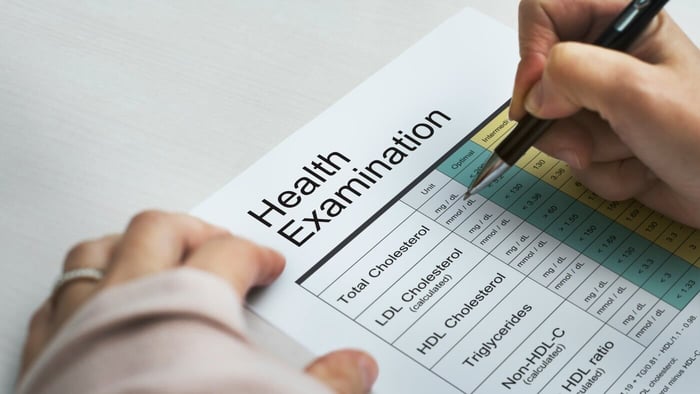Table of Contents
Apolipoprotein B (ApoB) is a protein present in low-density lipoprotein (LDL) that plays a major role in cholesterol and fat transportation. It is arguably a better biomarker for your risk of heart disease than the “gold standard” biomarker, total LDL levels.
Even though researchers have known ApoB was a superior diagnostic biomarker than total LDL for years, mainstream physicians and the culture at large have held onto the idea that your cholesterol levels are what predict heart attack, stroke, and other cardiovascular issues.
Keep reading to learn more about ApoB, the benefits of testing for ApoB, and strategies for ApoB management.
Read Next: The Truth About Cholesterol
ApoB and Cardiovascular Health
Apolipoprotein B (ApoB) plays a vital part in lipid transportation and is a key biomarker for cardiovascular disease (CVD). ApoB is found in or on the following non-HDL cholesterol lipids:
Intermediate-density lipoprotein (IDL)
Very low-density lipoprotein cholesterol (VLDL)
Chylomicrons
This protein attaches to cell receptors, allowing lipoproteins to pass through the cell membrane. Once inside the cell, the lipoprotein breaks down and releases cholesterol into your bloodstream, increasing the potential for atherosclerosis, which is a buildup of harmful plaque in your arteries.
There are 2 types of ApoB:
ApoB-48 is made in your gut. It carries lipids to your liver, where it is repackaged as the following type of apolipoprotein B.
ApoB-100 is made in your liver from ApoB-48. From the liver, apolipoprotein b-100 is transported throughout the body. This is the ApoB measured in a high-quality lipid profile.
ApoB is not a component of high-density lipoprotein cholesterol (HDL-C). HDL is typically called the “good” cholesterol, as it helps carry atherogenic lipoprotein particles like ApoB and lipoprotein (a), also called Lp(a), out of your arteries.
ApoB is related to but opposite of apolipoprotein A-1 (ApoA1). Whereas ApoB contributes to atherosclerosis, ApoA1 is largely found in HDL cholesterol and helps transport cholesterol from the blood and into the liver for excretion.
ApoB is the most precise measurement of atherosclerotic cardiovascular disease (ASCVD), as in adverse cardiovascular events that originate from blood vessels clogged with plaque. (1)
Testing
Apolipoprotein B has emerged as a new gold standard of predicting cardiovascular disease risk — better than total cholesterol or even low-density lipoprotein cholesterol (LDL-C) levels can predict ASCVD.
Some studies recommend ApoB as the best diagnostic tool specifically for people with high triglyceride levels, for whom LDL measurements are less accurate. (2) That’s just one example of when ApoB is a superior test to total LDL cholesterol.
Your doctor’s office may recommend fasting before a lipid panel, such as ApoB testing. ApoB is tested via a standard blood draw. Your results will be available in a few days. Your doctor will interpret the results and discuss them with you.
Measuring ApoB is better than measuring LDL-C levels for predicting cardiovascular disease risk because:
Despite mainstream “experts” calling LDL-C the “bad” cholesterol, total LDL-C doesn’t actually tell you how much heart-harmful material is in your blood. High ApoB, high Lp(a), and high amounts of small, dense LDL particles (as opposed to large, buoyant particles) are the harmful components that you should instead measure.
For decades, diagnostics that test total LDL-C have consistently failed to accurately predict CVD risk, sometimes overestimating and often underestimating. Testing ApoB, Lp(a), and LDL particle size has proved to be a more consistent, accurate diagnostic.
Cholesterol markers are not really an important diagnostic marker. Nearly 75 percent of patients hospitalized for a heart attack had blood cholesterol levels that would not indicate a high risk for a cardiovascular event, based on current national cholesterol guidelines. ApoB markers are more accurate predictors of your risk of clogged arteries. (3)
Interpreting Results
Your doctor should be able to take you through your results. If you want to interpret the results yourself or get an at-home test, you can confidently interpret your ApoB test results below.
Normal ApoB levels:
66 to 133 mg/dL for males
60 to 117 mg/dL for females
High Levels
If your levels of ApoB are higher than 117 or 133 mg/dL (for females and males, respectively), you have an increased risk of CVD, such as heart attack and coronary heart disease. Unfavorable lipid levels (including ApoB) is called dyslipidemia.
Your ApoB test results could be higher if any of these situations apply to you:
High cholesterol (hypercholesterolemia)
Kidney problems
Pregnancy
Low Levels
If your ApoB levels fall below the normal range for your gender (60 for females, 66 for males), it’s not directly negative. Still, it probably indicates an underlying medical issue that needs to be addressed.
Your ApoB test results may be lower if any of these situations apply to you:
Sepsis
Liver disease
Hyperthyroidism
Cirrhosis
Malnutrition
Estrogen medication
Genetic mutations to the ApoB gene, such as familial hypercholesterolemia
Strategies for Managing ApoB Levels
Managing ApoB levels is essential for reducing your risk of heart attack and stroke. Fortunately, there are several medical and natural treatments for keeping ApoB levels in a normal range.
Statins are the standard pharmaceutical approach to addressing cholesterol levels and — indirectly or perhaps ineffectively — ApoB levels. These chemical medications are synthesized to inhibit natural cholesterol production in your body. This unnatural process comes with side effects like aching and fatigue, as well as liver damage and kidney damage in rare cases. (4, 5) Statins may actually increase certain CVD biomarkers, making this class of medication an outdated treatment for reducing CVD risk. (6)
A healthy diet for reducing ApoB levels would include healthy fats (basically any dietary fat besides trans fats), fiber, protein, and tree nuts. (7, 8, 9) Avoid processed foods and trans fats. Alternatively, if you properly adhere to a ketogenic diet, you may reduce accurate CVD risk factors, including inflammation and ApoB. (10)
Regular exercise has been shown to reduce ApoB levels and CVD risk. (11) One study even found that exercise in overweight men reduced ApoB levels but not LDL levels, hitting home how LDL is not the most accurate way to predict heart health problems. (12)
Managing stress should help with ApoB levels. It’s generally accepted that stress increases your ApoB levels, LDL levels, and CVD risk. (13) Consider meditation or spending less time with screens and more time outdoors. (14)
Niacin (vitamin B3) has been shown to reduce ApoB levels, as well as improve other CVD risk biomarkers such as triglycerides and LDL particle size. (15)
Omega-3 fatty acids found in fish oil supplements and fatty fish can reduce fasting ApoB levels by 20%. (16) Not to mention the whole host of other benefits that omega-3s boast.
Nattokinase is a unique enzyme that supports heart health through fibrinolytic activity and helps support normal blood pressure, blood platelet function, and lipid metabolism. (17) Utilizing Eastern nutrients, nattokinase unlocks Japanese secrets to heart health. (18)
FAQs
Are ApoB levels more atherogenic than LDL?
Yes, ApoB levels are generally considered more atherogenic (artery-clogging) than LDL alone.
ApoB is the material in LDL cholesterol, which contributes to plaque buildup in your arteries. However, ApoB is also found in very-LDL and intermediate-density lipoprotein, making LDL a less accurate atherosclerosis biomarker.
What are the risks of an ApoB test?
The risks of an ApoB test are the same as any simple blood test. You may feel slight discomfort when the healthcare worker is drawing blood.
Does coffee raise ApoB?
Regular coffee intake may raise ApoB and LDL-C, but more than 2-3 cups of coffee a day has been shown to raise ApoB levels. (19, 20)
The Bottom Line
Apolipoprotein B is found in non-HDL-C (such as LDL, IDL, and VLDL). ApoB is atherosclerotic, meaning it contributes to clogged arteries. Measuring ApoB is a far superior diagnostic predictor for cardiovascular disease than cholesterol levels.
To support a healthy heart, make healthy lifestyle changes, and consider high-quality dietary supplements, like heart-healthy nattokinase or a nattokinase supplement.
Toku Flow is a daily supplement from Toku Health designed to promote healthy circulation, lipid balance, and metabolic wellness as part of a holistic heart‑health routine.
Sources
Use of apolipoprotein B in the era of precision medicine: time for a paradigm change?.
Statin use and the risk of kidney disease with long-term follow-up (8.4-year study).
Statins do not decrease small, dense low-density lipoprotein.
Nutrient patterns are associated with discordant apoB and LDL: a population-based analysis.
Variations in plasma lipid concentration during examination stress.
The role of nutraceutical supplements in the treatment of dyslipidemia.
Nattokinase: a promising alternative in prevention and treatment of cardiovascular diseases.
Habitual coffee intake and plasma lipid profile: Evidence from UK Biobank.
Coffee intake and elevated cholesterol and apolipoprotein B levels in men.




